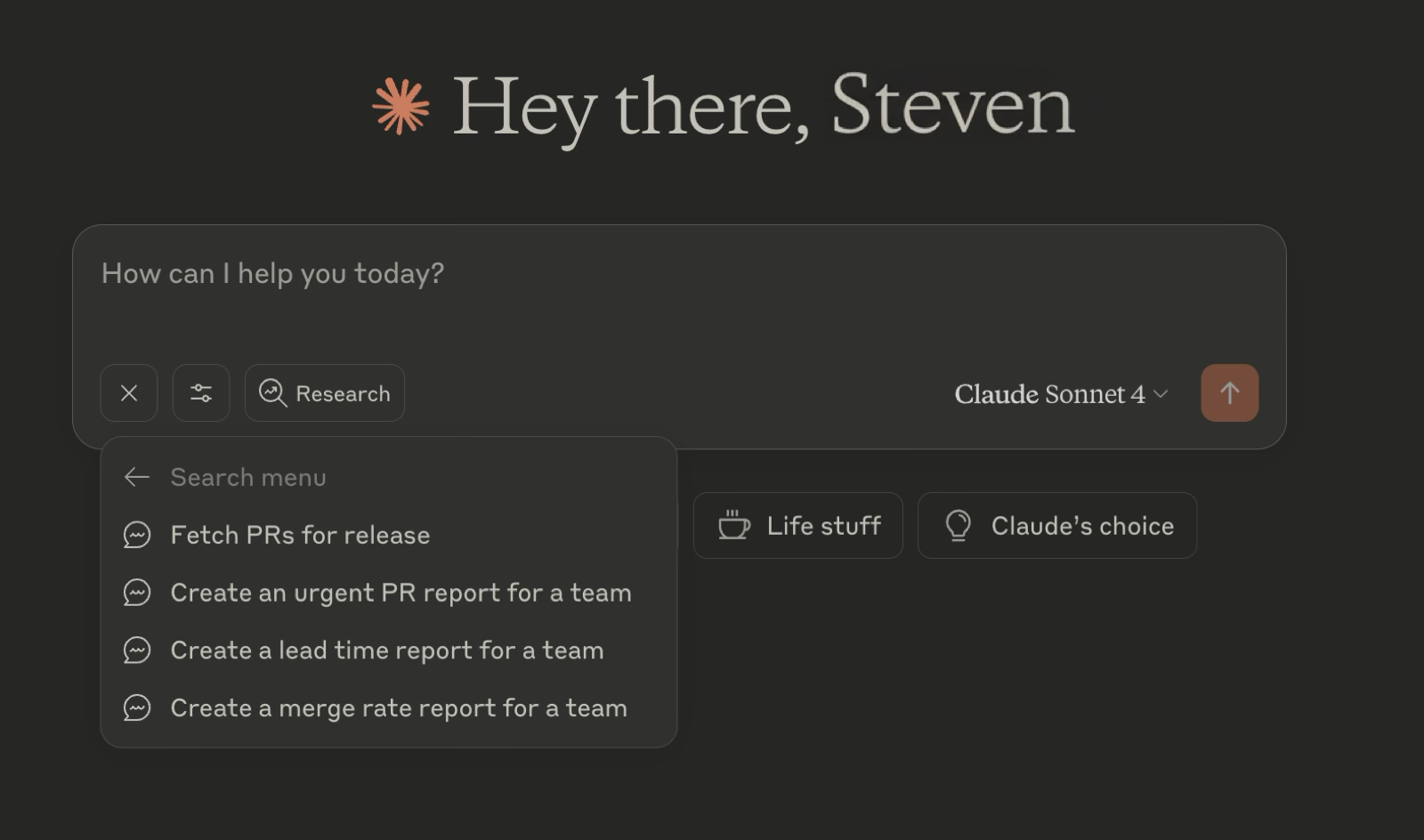Configuring the MCP Server in LinearB
This article explains how to configure the LinearB MCP (Model Context Protocol) server using either Claude Desktop with mcp-remote or Claude Code with a single CLI command. Once configured, Claude can connect to the LinearB MCP server, allowing you to securely use LinearB-specific prompts and extended capabilities. The guide covers prerequisites, installation steps for different operating systems, configuration methods, and how to access the Prompts panel in Claude.
This article describes how to configure the LinearB MCP (Model Context Protocol) server. You can connect in two ways, depending on your environment:
- Claude Desktop — using mcp-remote, which communicates with a remote LinearB MCP server through a JSON config file.
- Claude Code — using a single CLI command, which registers the LinearB MCP server directly.
Once configured, both methods allow Claude to access the LinearB MCP server.

Prerequisites
Make sure you have the following:
- Brew installed (for Mac)
- Claude Desktop installed
- Your LinearB API Key

Installation Procedure
There are two setup options available:
• Option 1: Claude Desktop — configure via mcp-remote and JSON.
• Option 2: Claude Code — configure with a single CLI command.

Option 1: Configure with Claude Desktop
- Run
node --versionin a terminal to check if Node.js is installed.
- If Node.js is installed, the command output displays a version number, for example v18.x.x.
- If Node.js is not installed, proceed with the relevant installation method, as described below.
OS | Procedure |
Windows/macOS |
|
MacOS (via Homebrew) | Run |
Linux (Debian/Ubuntu) | Run |
- Make the command line interface (CLI) available globally, by running
npm install -g mcp-remote. - Locate the executables:
- Get path to node:
which node - Get path to mcp-remote:
which mcp-remote
On Windows (Command Prompt or PowerShell), use:
where node
where mcp-remote
- Save the two paths—they will be needed to configure Claude.
- In Claude, go to Settings > Developer > Edit Config
- Add the following JSON block:
{
"mcpServers": {
"linearb": {
"command": "FULL_PATH_TO_NODE",
"args": [
"FULL_PATH_TO_MCP_REMOTE",
"https://mcp.linearb.io/mcp",
"--header",
"x-api-key: YOUR-API-KEY"
]
}
}
}- Replace the following in the JSON block:
- FULL_PATH_TO_NODE: from which node or where node
- FULL_PATH_TO_MCP_REMOTE: from which mcp-remote or where mcp-remote
- YOUR-API-KEY: your actual LinearB API Key
- Save the config file.
- Restart Claude Desktop.

Option 2: Configure with Claude Code
If you are using Claude Code instead of Claude Desktop, you don’t need to edit the JSON config manually. Instead, you can run a single command to connect directly to the LinearB MCP server:
• It provides a faster setup if you’re coding directly with Claude.
• Behavior is consistent: after setup, you can query LinearB MCP resources just like with the desktop configuration.
claude mcp add --transport http linearb https://mcp.linearb.io/mcp --header "x-api-key: LINEARB_API_TOKEN"
Replace LINEARB_API_TOKEN with your actual LinearB API key.
Once executed, Claude Code will register the LinearB MCP server and make it available for use.

Usage
The LinearB MCP server is a Beta feature. Behavior and outputs may change before general availability.
Numbers and data outputs from the MCP—like any generative AI results—should be verified for accuracy. To ensure correctness, we recommend reproducing results in the LinearB UI Dashboard before using any MCP-generated metrics for critical decisions.
For a reference of ready-to-use queries, see the LinearB MCP Server Prompt Library (PDF).
Once configured, the MCP server allows you to:
- Manage settings through a single JSON file instead of multiple manual configurations.
- Authenticate securely with your LinearB API token.
- Apply consistent configuration across environments.
- Access extended capabilities beyond the public API, using supported internal endpoints.
- Access Claude’s built-in Prompts panel to use LinearB-specific prompts.

Accessing the Prompts Panel in Claude Desktop
- Open Claude Desktop. From the welcome screen, you’ll see the main prompt bar.
- Click +, and select Add from LinearB Metrics to load the set of unique LinearB prompts.
- Once enabled, these prompts will appear directly in the Claude interface, allowing you to quickly generate PR reports, lead time reports, merge rate reports, and other LinearB-specific outputs without additional configuration.




Related Articles
How did we do?
Configuring LinearB AI and Automations
Enabling LinearB AI Services